This article needs additional citations for verification .(January 2009) |
Flying Saucers was a monthly magazine published and edited by Raymond A. Palmer, devoted to articles on UFOs and the Shaver Mystery. [1] [2]
This article needs additional citations for verification .(January 2009) |
Flying Saucers was a monthly magazine published and edited by Raymond A. Palmer, devoted to articles on UFOs and the Shaver Mystery. [1] [2]
The magazine was first published as Flying Saucers from Other Worlds in 1957, [2] before evolving into Flying Saucers in 1958. The initial title was designed to create confusion with a science fiction magazine Other Worlds , which Palmer also published and which overlapped for two issues. Such confusion may have been designed to overcome the difficulty that a new magazine in a new category would have in finding space on news stands, to help attract readership, or more likely both. The confusion continues to tax magazine collectors to this day.
Flying Saucers From Other Worlds was first published in June 1957 and cost 35 cents an issue. The editorial by Ray Palmer on page 4 begins with "This is the first Flying Saucers From Other Worlds. Ray A. Palmer was Editor, Gray Barker was Eastern Editor and August C. Roberts was Photo Editor. Col. Ron Ormond was Western Editor several issues later. The front cover of issue number one was a composite from the movies Forbidden Planet" and "Captive Women". The editorial address was in Amherst, Wisconsin. The magazine itself was published by Palmer Publications, Inc. in Evanston, Illinois.
The Flying Saucers From Other Worlds May 1958 Issue No. 29 was the last one by that title. In the July–August 1958 Issue No. 30 the name of the magazine was changed to Flying Saucers, The Magazine of Space Conquest. Ray Palmer was still editor at that time. The title was later changed to Flying Saucers, Mysteries of the Space Age and the magazine continued until June 1976 when it ceased publication.

If was an American science fiction magazine launched in March 1952 by Quinn Publications, owned by James L. Quinn.
Donald Edward Keyhoe was an American Marine Corps naval aviator, writer of many aviation articles and stories in a variety of leading publications, and manager of the promotional tours of aviation pioneers, especially of Charles Lindbergh.

Amazing Stories is an American science fiction magazine launched in April 1926 by Hugo Gernsback's Experimenter Publishing. It was the first magazine devoted solely to science fiction. Science fiction stories had made regular appearances in other magazines, including some published by Gernsback, but Amazing helped define and launch a new genre of pulp fiction.

Raymond Arthur Palmer was an American author and editor, best known as editor of Amazing Stories from 1938 through 1949, when he left publisher Ziff-Davis to publish and edit Fate Magazine, and eventually many other magazines and books through his own publishing houses, including Amherst Press and Palmer Publications. In addition to magazines such as Mystic,Search, and Flying Saucers, he published or republished numerous spiritualist books, including Oahspe: A New Bible, as well as several books related to flying saucers, including The Coming of the Saucers, co-written by Palmer with Kenneth Arnold. Palmer was also a prolific author of science fiction and fantasy stories, many of which were published under pseudonyms.
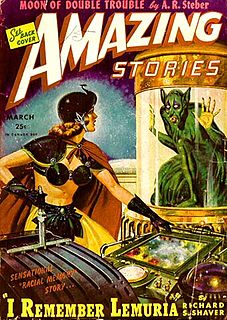
Richard Sharpe Shaver was an American writer and artist.

Fortean Times is a British monthly magazine devoted to the anomalous phenomena popularised by Charles Fort. Previously published by John Brown Publishing, I Feel Good Publishing, Dennis Publishing, and Exponent (2021), it is now published by Diamond Publishing, part of Metropolis International.
Kenneth Albert Arnold was an American aviator, businessman, and politician.

Aviation Week & Space Technology, often abbreviated Aviation Week or AW&ST, is the flagship magazine of the Aviation Week Network. The weekly magazine is available in print and online, reporting on the aerospace, defense and aviation industries, with a core focus on aerospace technology. It has a reputation for its contacts inside the United States military and industry organizations.
In ufology, the psychosocial hypothesis, abbreviated PSH, argues that at least some UFO reports are best explained by psychological or social means. It is often contrasted with the better-known extraterrestrial hypothesis (ETH), and is particularly popular among UFO researchers in the United Kingdom, such as David Clarke, Hilary Evans, the editors of Magonia magazine, and many of the contributors to Fortean Times magazine. It is also popular in France since the publication in 1977 of a book written by Michel Monnerie, Et si les ovnis n'existaient pas?.

Other Worlds, Universe Science Fiction, and Science Stories were three related US magazines edited by Raymond A. Palmer. Other Worlds was launched in November 1949 by Palmer's Clark Publications and lasted for four years in its first run, with well-received stories such as "Enchanted Village" by A. E. van Vogt and "Way in the Middle of the Air", one of Ray Bradbury's "Martian Chronicle" stories. Since Palmer was both publisher and editor, he was free to follow his own editorial policy, and presented a wide array of science fiction.

Wonder Stories was an early American science fiction magazine which was published under several titles from 1929 to 1955. It was founded by Hugo Gernsback in 1929 after he had lost control of his first science fiction magazine, Amazing Stories, when his media company Experimenter Publishing went bankrupt. Within a few months of the bankruptcy, Gernsback launched three new magazines: Air Wonder Stories, Science Wonder Stories, and Science Wonder Quarterly.

George Hunt Williamson, aka Michael d'Obrenovic and Brother Philip, was an American flying saucer contactee, channel, and metaphysical author who came to prominence in the 1950s.

Imagination was an American fantasy and science fiction magazine first published in October 1950 by Raymond Palmer's Clark Publishing Company. The magazine was sold almost immediately to Greenleaf Publishing Company, owned by William Hamling, who published and edited it from the third issue, February 1951, for the rest of the magazine's life. Hamling launched a sister magazine, Imaginative Tales, in 1954; both ceased publication at the end of 1958 in the aftermath of major changes in US magazine distribution due to the liquidation of American News Company.

Roger Phillip Graham was an American science fiction writer who was published most often using the name Rog Phillips, but also used other names. Of his other pseudonyms, only Craig Browning is notable in the genre. He is associated most with Amazing Stories and is known best for short fiction. He was nominated for the Hugo Award for Best Novelette in 1959.
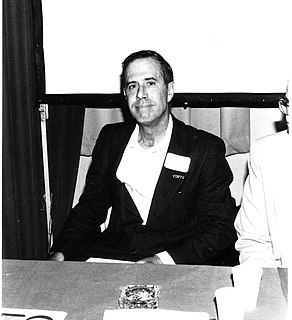
James Willett Moseley was an American observer, author, and commentator on the subject of unidentified flying objects (UFOs). Over his nearly sixty-year career, he exposed UFO hoaxes and engineered hoaxes of his own. He was best known as the publisher of the UFO newsletters Saucer News and its successor Saucer Smear, which became the longest continuously published UFO journal in the world.
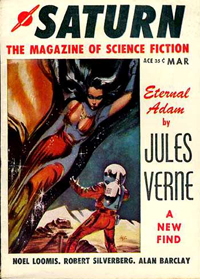
Saturn was an American magazine published from 1957 to 1965. It was launched as a science fiction magazine, but sales were weak, and after five issues the publisher, Robert C. Sproul, switched the magazine to hardboiled detective fiction that emphasized sex and sadism. Sproul retitled the magazine Saturn Web Detective Story Magazine to support the change, and shortened the title to Web Detective Stories the following year. In 1962, the title was changed yet again, this time to Web Terror Stories, and the contents became mostly weird menace tales—a genre in which apparently supernatural powers are revealed to have a logical explanation at the end of the story.

Imaginative Tales was an American fantasy and science fiction magazine launched in September 1954 by William Hamling's Greenleaf Publishing Company. It was created as a sister magazine to Imagination, which Hamling had acquired from Raymond A. Palmer's Clark Publishing. Imaginative Tales began as a vehicle for novel-length humorous fantasy, early issues featuring stories by Charles F. Myers and Robert Bloch. After a year, Hamling switched the focus to science fiction and it became similar in content to Imagination, publishing routine space operas. In 1958, with public interest in space high, Hamling changed the title to Space Travel, but there was little effect on sales. Magazine circulation was suffering because of the rise of the paperback, and the liquidation in 1957 of American News Company, a major magazine distributor, made it even harder for small magazines to survive. Hamling eventually ceased publication of both Imaginative Tales and Imagination in 1958, preferring to invest the money in Rogue, a men's magazine he had started in imitation of Playboy in 1955.
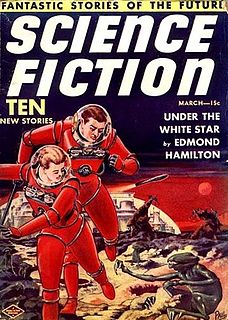
Future Science Fiction and Science Fiction Stories were two American science fiction magazines that were published under various names between 1939 and 1943 and again from 1950 to 1960. Both publications were edited by Charles Hornig for the first few issues; Robert W. Lowndes took over in late 1941 and remained editor until the end. The initial launch of the magazines came as part of a boom in science fiction pulp magazine publishing at the end of the 1930s. In 1941 the two magazines were combined into one, titled Future Fiction combined with Science Fiction, but in 1943 wartime paper shortages ended the magazine's run, as Louis Silberkleit, the publisher, decided to focus his resources on his mystery and western magazine titles. In 1950, with the market improving again, Silberkleit relaunched Future Fiction, still in the pulp format. In the mid-1950s he also relaunched Science Fiction, this time under the title Science Fiction Stories. Silberkleit kept both magazines on very slim budgets throughout the 1950s. In 1960 both titles ceased publication when their distributor suddenly dropped all of Silberkleit's titles.

Science-fiction and fantasy magazines began to be published in the United States in the 1920s. Stories with science-fiction themes had been appearing for decades in pulp magazines such as Argosy, but there were no magazines that specialized in a single genre until 1915, when Street & Smith, one of the major pulp publishers, brought out Detective Story Magazine. The first magazine to focus solely on fantasy and horror was Weird Tales, which was launched in 1923, and established itself as the leading weird fiction magazine over the next two decades; writers such as H.P. Lovecraft, Clark Ashton Smith and Robert E. Howard became regular contributors. In 1926 Weird Tales was joined by Amazing Stories, published by Hugo Gernsback; Amazing printed only science fiction, and no fantasy. Gernsback included a letter column in Amazing Stories, and this led to the creation of organized science-fiction fandom, as fans contacted each other using the addresses published with the letters. Gernsback wanted the fiction he printed to be scientifically accurate, and educational, as well as entertaining, but found it difficult to obtain stories that met his goals; he printed "The Moon Pool" by Abraham Merritt in 1927, despite it being completely unscientific. Gernsback lost control of Amazing Stories in 1929, but quickly started several new magazines. Wonder Stories, one of Gernsback's titles, was edited by David Lasser, who worked to improve the quality of the fiction he received. Another early competitor was Astounding Stories of Super-Science, which appeared in 1930, edited by Harry Bates, but Bates printed only the most basic adventure stories with minimal scientific content, and little of the material from his era is now remembered.
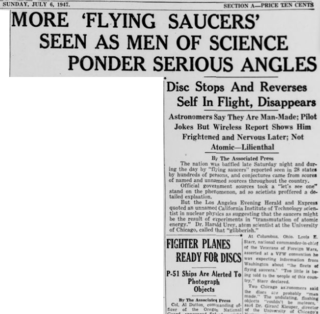
The Rhodes UFO photos, sometimes called the shoe-heel UFO photos, refers to two photos that were reportedly taken on July 7, 1947 by William A. Rhodes. The photographs purported to show a disc-like object flying above Phoenix, Arizona. Rhodes's account and photographs were published by the Arizona Republic on July 9.